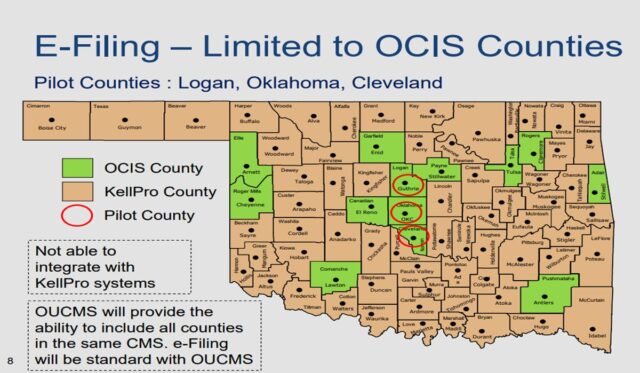

After decades of discussion and development, Oklahoma’s glacial journey to e-filing in state court appears nearly ready to bear some fruit.
While the ability to file case documents electronically has been available since 2002 in federal courts, state courts across Oklahoma’s 77 counties still require paper filings submitted in person or by mail 27 years after the Legislature first authorized e-filing in 1997.
Since then, the elongated effort has involved two private vendors, two different in-house software developments and one bankrupt company. But after nearly three decades of attempts, the state’s first permanent e-filing program appears nearly ready for use — at least in some counties.
An e-filing pilot program is set to start in Cleveland, Logan and Oklahoma counties in July with eventual plans to open the program to all 13 counties using the OCIS software for court management. KellPro, the other court management software used in Oklahoma’s other 64 counties, cannot currently be integrated with the state’s e-filing software, which is a module of the Oklahoma Unified Court Management System operated by the Administrative Office of the Courts.
After working the past 12 years to bring e-filing to the Oklahoma state court system, program manager Frank Holdsclaw said ongoing e-filing beta tests in the pilot programs have gone well so far.
“We got good feedback, and there weren’t any showstoppers,” Holdsclaw said. “Just a couple of things we hadn’t thought about and, of course, that’s why we do it.”
The current pilot programs’ progress stands in contrast with the state’s first pilot, which ended in 2014 when the Oklahoma Supreme Court canceled the state’s contract with the software vendor AMCAD.
This time around, the Administrative Office of the Courts decided to develop the software in house, hiring two developers, one business analyst and a quality assurance tester who have worked on the projectfor the past five years.
“It’s kind of a different approach. You know, 10 years ago, we had an outside vendor, and we were basically just administering that contract,” Holdsclaw said.
The ultimate goal of the program is to allow most court filings to be fileable virtually.
“We have kind of — not a motto — but an unofficial statement that our goal is: If you can do it at the counter, you’ll be able to do it online,” said Holdsclaw.
E-filing rollout limited, plans to expand

Despite his optimism, Holdsclaw is quick to note that although virtual filing may be the goal for most documents, there will be lots of exceptions in the e-filing software.
As constructed currently, the system allows for filing most documents in existing civil cases. But the software does not currently support e-filing for criminal cases, nor initial filings for any case. Some types of court documents are also required by statute to be filed in person.
“There’s some things that you have to physically do,” Holdsclaw said. “By statute, you have to do (some things) in person at the counter in the county clerk’s office, like turning in your marriage license, for example. Or if you want to file something that is a confidential case or a sealed document, we’re not going to do that online.”
However, there are plans to expand the software after its initial release. According to a Jan. 19 PowerPoint provided by Holdsclaw (embedded below), the project’s “second release” plans to add existing criminal cases.
Greg Mashburn, the Cleveland County district attorney whose county has participated in tests of the new e-filing system, expressed support for eventually expanding e-filing to criminal cases.
“I actually had a conversation last week with (administrative director of the courts) Jari Askins about maybe moving forward and expanding it. Even if it’s just Cleveland County, to do a pilot program on criminal stuff,” Mashburn said in mid-February. “It’s definitely something that can help cut costs and move the process more quickly.”
Sen. Brent Howard also voiced his support for an e-filing option, but he wants to ensure in-person filing remains an option.
“It should be available as an option,” Howard (R-Altus) said of e-filing. “I think a lot of people (would) like to see it as an option, but not necessarily a requirement.”
While participants in the beta and pilot programs seem eager for expanded functionality in civil e-filing and for the implementation of the software for criminal cases, other counties using the KellPro software face a longer road to any e-filing option.
In-house developments, vendor issues and e-filing delays

The Oklahoma Legislature first authorized e-filing by statute in 1997 and has amended another section related to e-filing several times since.
In a December 2010 Oklahoma Bar Journal article, Oklahoma Supreme Court Justice James Edmondson announced the replacement of Oklahoma’s two incompatible court operating softwares — KellPro and OCIS — with a new “unified case management system” that would modernize the Oklahoma court system. Fourteen years later, every county in Oklahoma still uses either KellPro or OCIS.
OCIS is managed in house by the Administrative Office of the Courts and was initially authorized by statute in 1985. Development on the OCIS software began in the 1990s with the goal of it being used in all 77 Oklahoma counties.
However, as the OCIS software development was underway in the 2000s, KellPro, a private company, launched its own competing system that garnered use in the majority of Oklahoma’s counties.
By 2010, the Administrative Office of the Courts shifted focus from the development of OCIS to contracting with outside vendor AMCAD, or American Cadastre, to develop a new software. AMCAD beat out KellPro for the software development contract.
Oklahoma’s first attempt at implementing e-filing wasn’t until 2012 when the Oklahoma Supreme Court released a SCAD order with court rules for e-filing.
Around 2013, Holdsclaw said AMCAD created and maintained the software for a pilot program that ran in Noble County. While Holdsclaw did not recall the details surrounding the end of the AMCAD contract, reporting from the Associated Press in June 2014 indicates the contract was canceled after the Legislature directed the Oklahoma Supreme Court to use one third of the funding designated for the program to fund court operations.
At the time, then-Rep. Mark McCullough, who was chairman of the House budget subcommittee that oversaw funding for the courts, speculated that the real reason stemmed from problems with the state’s vendor, AMCAD.
“I don’t think it’s an unreasonable theory that they potentially got disenchanted with the vendor and then tried to pin this on the Legislature,” McCullough (R-Sapulpa) said in June 2014.
By June 2015, AMCAD withdrew from providing court software nationally, and the company was bankrupt by September, according to Government Technology, an industry magazine covering “information technology’s role in state and local governments.”
Holdsclaw said there was a gap of a few years between the end of the AMCAD contract and the planning for the current move to implement e-filing.
“The court basically had other priorities to work on until about five years later when the court said, ‘Well, let’s start up e-filing again,'” Holdsclaw said.
The Administrative Office of the Courts shifted focus back to the in-house development of an e-filing system. While there are plans to roll the software out statewide eventually, it is currently unable to integrate with KellPro software, meaning either KellPro integration will have to be developed — in which case Oklahoma will continue to employ multiple court management software systems — or counties using KellPro will need to adopt OCIS to implement e-filing.
“So we won’t be able to e-file in those counties until such time as we either develop a new interface or maybe they replace their system with something else,” Holdsclaw explained. “But the good side is that’s about half the filings — about half the court filings occur in those 13 (OCIS) counties.”
Until such a change is implemented, e-filing will only be limited in counties using the OCIS software: Adair, Canadian, Cleveland, Comanche, Ellis, Garfield, Logan, Oklahoma, Payne, Pushmataha, Roger Mills, Rogers, and Tulsa.
Holdsclaw said that while Oklahoma’s three appellate courts will ultimately be included in the e-filing program, they will likely brought online last.
Follow @NonDocMedia on:
Facebook | X | Text or Email
Beta tests, pilot programs and early adopters

Oklahoma’s new e-filing pilot program started with 45 attorneys whom Holdsclaw called “early adopters” of the system.
“(They are) people who are willing to try out this system, realizing there might be kinks in it,” he said. “And we did that beta test with them a couple months earlie,r and that all worked out, too.”
According to Holdsclaw, the Administrative Office of the Courts ran a “beta test” in Logan, Oklahoma and Cleveland counties for a few weeks.
“We have beta tested with the three counties with our system,” Holdsclaw said. “We have another round of beta tests to do with them, which we’ll probably do in a few weeks.”
The next stage of the pilot program will also take place around July in the three central Oklahoma counties.
“Cleveland, Oklahoma and Logan counties will be our three pilots, and we’ll implement all three basically at the same time,” Holdsclaw said. “We might have a couple days’ delay between them so we can train the clerks.”
Holdsclaw said he thinks that after a few weeks of the pilot program and a “new release,” the rollout in other OCIS counties should begin.
“I’m expecting that we’ll have our pilot for about three weeks. We’ll probably then do a new release, and at that point we will simply schedule each of the other counties to jump on,” Holdsclaw said. “Mainly, the thing that will be slowing us down is simply we have to take a few days to train the clerks.”
A representative for Oklahoma County Court Clerk Rick Warren declined a request for an interview about their office’s pilot program experiences.
House Appropriations and Budget Chairman Kevin Wallace, who is still pushing a proposal for a new judicial evaluation program, indicated he believed that the users of the court system should be the primary funders of e-filing implementation.
“The users of the court — the users of any service — should be the ones paying the support of the structure of the system,” said Wallace (R-Wellston). “But the argument on the backside is, well, it’s better support for people in trouble criminally.”
Review a Powerpoint describing the Oklahoma e-filing project
